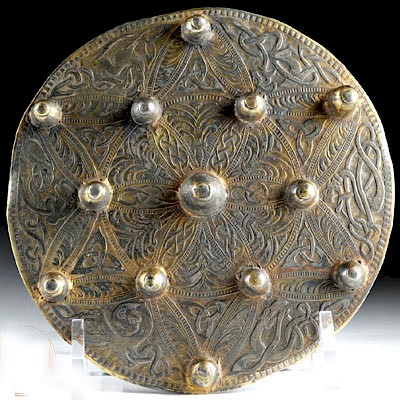Fine Achaemenid Silver Bowl w/ Incised Details
Lot 64
About Seller
Artemis Fine Arts
686 S Taylor Ave, Ste 106
Louisville, CO 80027
United States
Selling antiquities, ancient and ethnographic art online since 1993, Artemis Gallery specializes in Classical Antiquities (Egyptian, Greek, Roman, Near Eastern), Asian, Pre-Columbian, African / Tribal / Oceanographic art. Our extensive inventory includes pottery, stone, metal, wood, glass and textil...Read more
Estimate:
$1,800 - $2,500
Absentee vs Live bid
Two ways to bid:
- Leave a max absentee bid and the platform will bid on your behalf up to your maximum bid during the live auction.
- Bid live during the auction and your bids will be submitted real-time to the auctioneer.
Bid Increments
| Price | Bid Increment |
|---|---|
| $0 | $25 |
| $300 | $50 |
| $1,000 | $100 |
| $2,000 | $250 |
| $5,000 | $500 |
| $10,000 | $1,000 |
| $20,000 | $2,500 |
| $50,000 | $5,000 |
| $100,000 | $10,000 |
| $200,000 | $20,000 |
About Auction
By Artemis Fine Arts
Jul 19, 2018
Set Reminder
2018-07-19 10:00:00
2018-07-19 10:00:00
America/New_York
Bidsquare
Bidsquare : Fine Antiquities/Ethnographic Art
https://www.bidsquare.com/auctions/artemis-gallery/fine-antiquities-ethnographic-art-3329
Featuring classical antiquities, ancient and ethnographic art from cultures encompassing the globe, plus fine art. Artemis Fine Arts info@artemisgallery.com
Featuring classical antiquities, ancient and ethnographic art from cultures encompassing the globe, plus fine art. Artemis Fine Arts info@artemisgallery.com
- Lot Description
Ancient Near East, Achaemenid Persian Empire, ca. 550 to 350 BCE. A gorgeous silver bowl of sterling quality and a simple yet elegant form. The vessel exhibits a stable, indented base, rounded walls exhibiting an incised register of openwork triangles with a stippled base ring, and a rolled shoulder with an incised concentric tongue motif. The rim is set slightly inside the shoulder's upper periphery and dramatically flares outward, leading in towards a shallow interior tondo. The exterior design is made by impressing repeated tiny lines into the silver surface, giving it a textured appearance. The bottom of the exterior presents dozens of slender mold-formed ribs radiating outwards from the central indentation in low relief. A stupendous example replete with meticulous detailing and a sophisticated presentation. Size: 4.6" W x 2.125" H (11.7 cm x 5.4 cm); total weight: 184.9 grams; quality of silver: 95% or higher.
Libation bowls, known as phiale, were used across a wide geographical area - from Greece to Tibet, throughout the ancient Near East and Central Asia. These shallow bowls for holding wine in ritual and ceremonial settings were made from many materials - glass, ceramic, and many kinds of metal. Only royal vessels were made of precious metals, like this one. They functioned both as tableware and as emblems of wealth. Silver phiale like this example could be stored in the royal treasury or given as gifts to people the leaders were hoping to influence.
For a similar example, please see The British Museum, registration number 1925, 1019.1: https://www.britishmuseum.org/research/collection_online/collection_object_details.aspx?objectId=367830&partId=1&images=true
Provenance: private East Coast, USA collection
All items legal to buy/sell under U.S. Statute covering cultural patrimony Code 2600, CHAPTER 14, and are guaranteed to be as described or your money back.
A Certificate of Authenticity will accompany all winning bids.
We ship worldwide and handle all shipping in-house for your convenience.
#133236Surface wear and abrasions commensurate with age and use, slight bending to overall form, small indentations to rim and body, and some tarnishing to interior and exterior, otherwise intact and excellent. Light earthen deposits within some incised details.Condition
- Shipping Info
-
All shipping is handled in-house for your convenience. Your invoice from Artemis Gallery will include shipping calculation instructions. If in doubt, please inquire BEFORE bidding for estimated shipping costs for individual items.
-
- Buyer's Premium



 EUR
EUR CAD
CAD AUD
AUD GBP
GBP MXN
MXN HKD
HKD CNY
CNY MYR
MYR SEK
SEK SGD
SGD CHF
CHF THB
THB

















